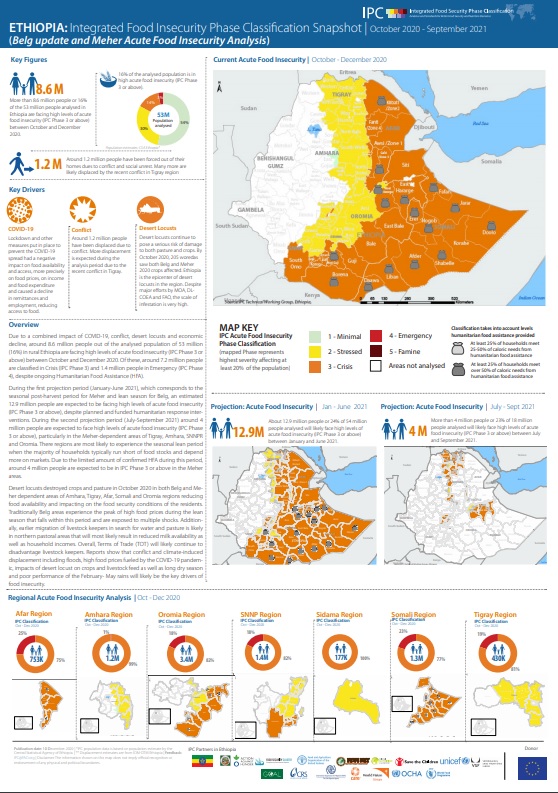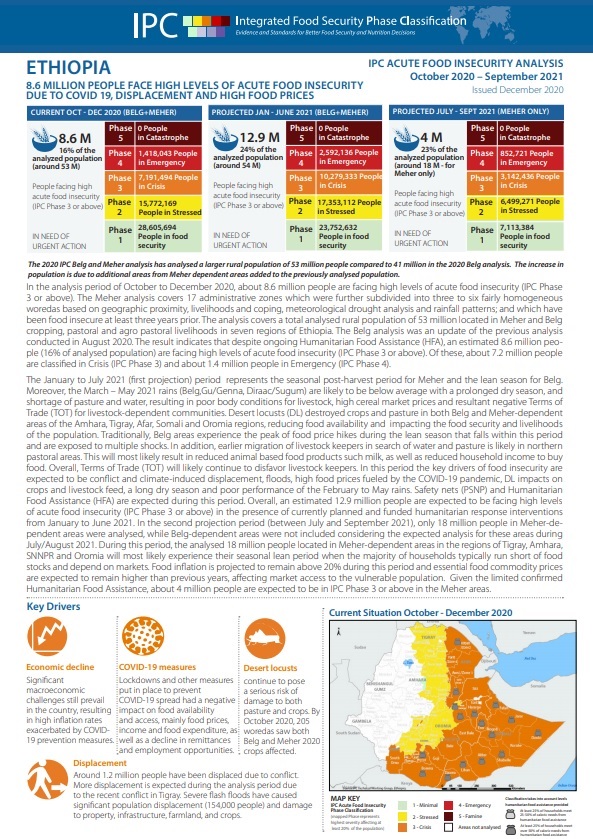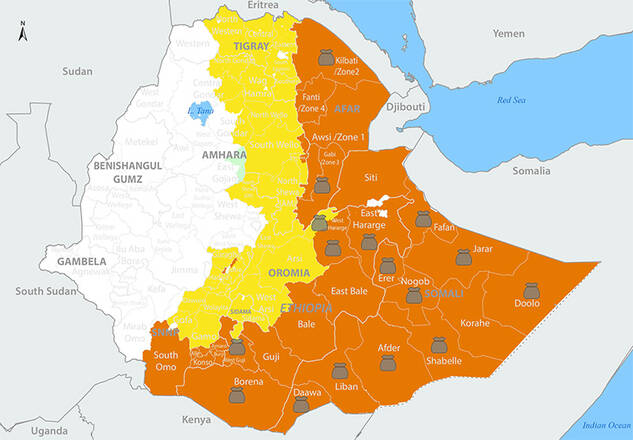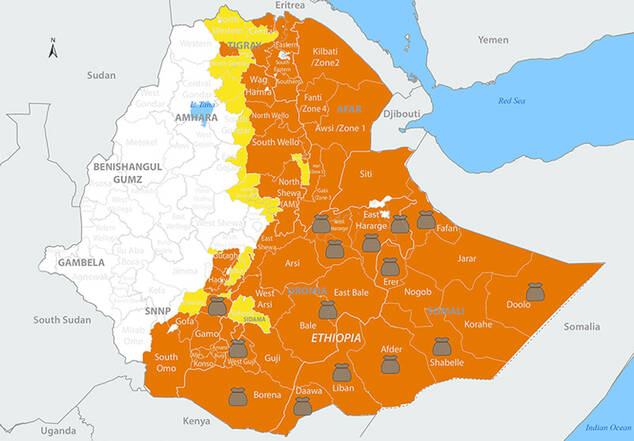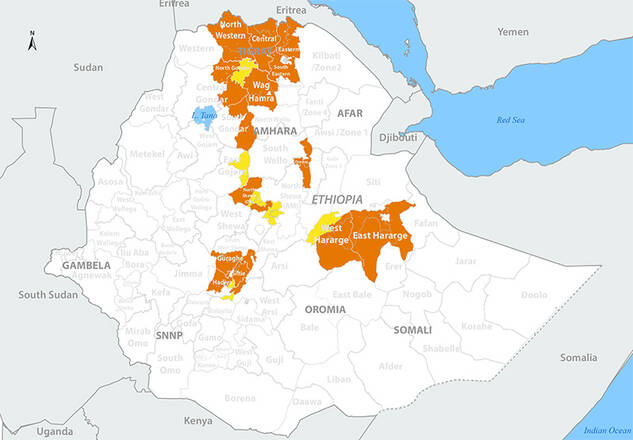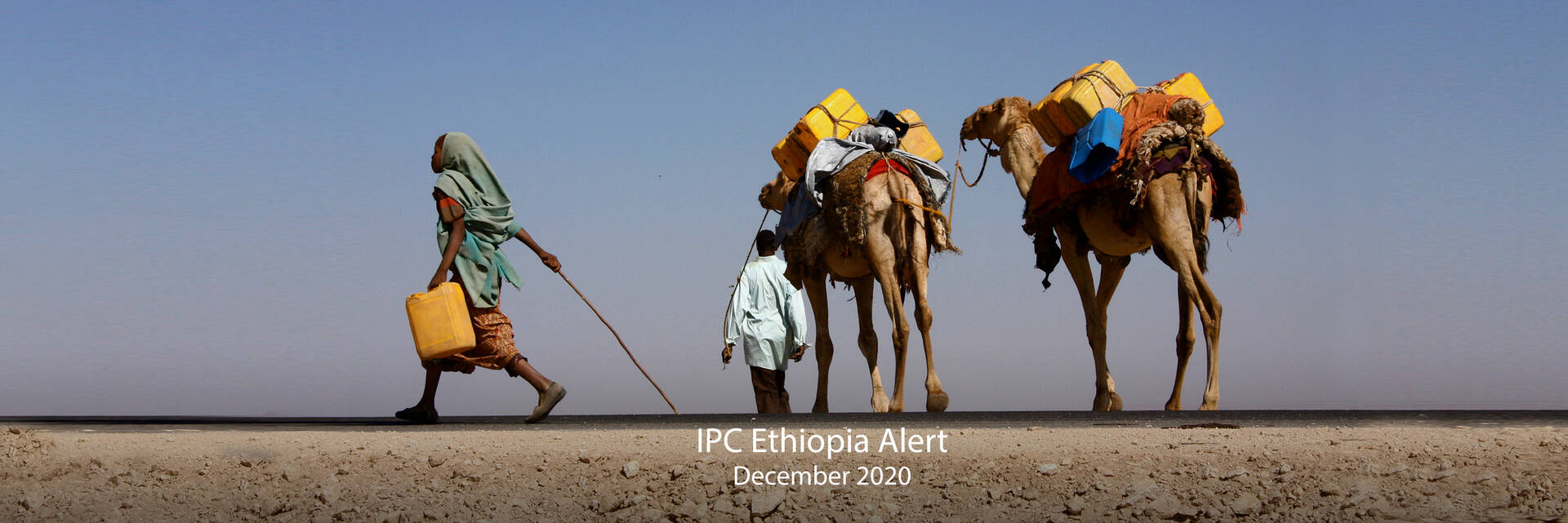
- © IPC
Over 8.6 million people in seven regions of Ethiopia face high levels of acute food insecurity
Overview
In the analysis period of October to December 2020, about 8.6 million people are facing high levels of acute food insecurity (IPC Phase 3 or above). The Meher analysis covers 17 administrative zones which were further subdivided into three to six fairly homogeneous woredas based on geographic proximity, livelihoods and coping, meteorological drought analysis and rainfall patterns; and which have been food insecure at least three years prior. The analysis covers a total analysed rural population of 53 million located in Meher and Belg cropping, pastoral and agro pastoral livelihoods in seven regions of Ethiopia. The Belg analysis was an update of the previous analysis conducted in August 2020. The result indicates that despite ongoing Humanitarian Food Assistance (HFA), an estimated 8.6 million people (17% of analysed population) are facing high levels of acute food insecurity (IPC Phase 3 or above). Of these, about 7.2 million people are classified in Crisis (IPC Phase 3) and about 1.4 million people in Emergency (IPC Phase 4). Download the snapshot here.
Actions Needed
- Provide urgent actions to save lives and livelihoods of populations estimated in Emergency (IPC Phase 4), as well as to protect livelihoods and reduce food consumption gaps of the populations estimated in Crisis (IPC Phase 3). A special focus should also be directed towards the households unable to purchase food due to a lack of employment and other income sources because of the COVID-19 pandemic;
- Provide emergency agricultural and livestock support to farmers, with a special focus on administrative zones affected by natural disasters, including floods, drought and desert locusts. Scale up diversified livelihoods programs for improved self-reliance, resilience building and social protection to all vulnerable communities classified in Stressed (IPC Phase 2), Crisis (IPC Phase 3) and Emergency (IPC Phase 4);
- Implement agriculture and market polices including localized cultivation of improved seeds;
- Rehabilitate infrastructure (roads, markets) to ensure easy access for traders and suitable infrastructure and implement water harvesting programs in water-deficit Administrative Zones;
- Scale up and improve access to basic services (health and WASH) throughout the year. In areas affected by shortage of water and public health challenges, improve access to water, hygiene and sanitation for affected populations as well as improve access to water to support community-based initiatives that contribute to stabilize and maintain livelihoods;
- Strengthen and support initiatives addressing cross-cutting issues of food security and nutrition status of vulnerable groups, promote good nutritional practices at household levels through nutrition sensitive activities, such as home gardening and educational awareness on food and water safety;
- Restore and enhance the livelihoods of IDP returnees as well as vulnerable farming and pastoralist communities by subsidizing basic commodities and agricultural inputs;
- Continue the public works programs under the safety nets program and rehabilitation of rural community assets, through food- and cash-based transfers aimed at improving access to food and restoring employment opportunities disrupted by the COVID-19 pandemic;
- Support ongoing initiatives on social cohesion and peace-building efforts in order to reduce the impact of conflicts on food security, nutrition and livelihoods of affected populations. The conflict-induced displacement has continued damaging the lives and livelihoods of the affected population. The humanitarian community, donors and partners should continue advocating for and implementing an integrated approach of providing humanitarian assistance, in parallel to increasing the resilience of livelihoods and continuous monitoring of the IDP situation;
- Proactively identify means to provide life and livelihoods support to the people displaced due to the recent conflict and prioritize diverse humanitarian interventions.
- The response analysis and planning should consider additional investments in response to the COVID-19 shock, as well as resilience and adaptation to climate change, to provide food insecure households with a buffer against future shocks and stop the cycle of recurring food crises
High levels of acute food insecurity due to COVID-19, displacement, desert locusts and high food prices.
The key drivers of Ethiopia's acute food insecurity situation are summarized as follows: Economic decline: Significant macroeconomic challenges still prevail in the country, resulting in high inflation rates exacerbated by COVID-19 prevention measures; COVID-19 measures: Lockdowns and other measures put in place to prevent COVID-19 spread had a negative impact on food availability and access, mainly food prices, income and food expenditure, as well as a decline in remittances and employment opportunities; Desert locusts continue to pose a serious risk of damage to both pasture and crops. By October 2020, 205 woredas saw both Belg and Meher 2020 crops affected; Displacement: Around 1.2 million people have been displaced due to conflict. More displaced people are expected during the analysis period due to the recent conflict in Tigray. Severe flash floods have caused significant population displacement (154,000 people) and damage to property, infrastructure, farmland , and crops. Download the brief here
Population in IPC Phases
IPC Classification Map

Join our mailing list

